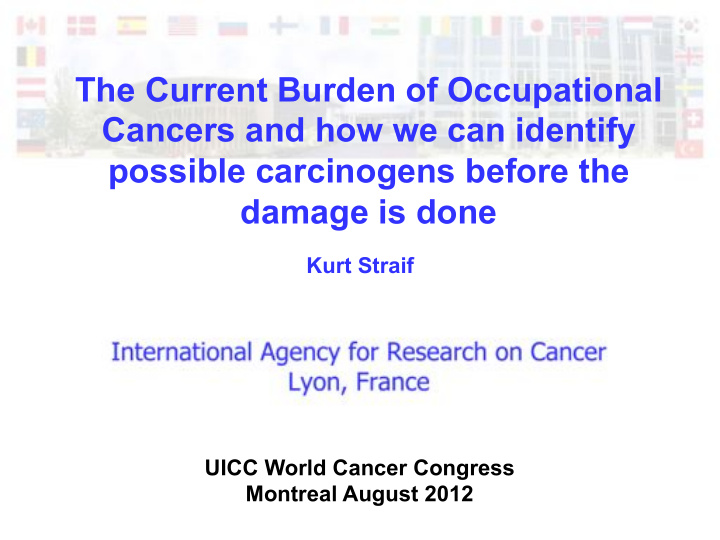



The Current Burden of Occupational Cancers and how we can identify possible carcinogens before the damage is done Kurt Straif UICC World Cancer Congress Montreal August 2012
IARC Monographs “The encyclopaedia of carcinogens” • For national and international health agencies – Source of scientific information on known and suspected carcinogens – Scientific support for actions to prevent exposure Lorenzo Tomatis • Over 900 agents evaluated: 1929-2007 – Chemicals, Complex mixtures – Occupational exposures – Physical and biological agents – Lifestyle factors • Group Classification of agent to humans No. agents – 1 carcinogenic 108 – 2A probably carcinogenic 64 – 2B possibly carcinogenic 27
Classification of Carcinogens: First Combine evidence in Humans and in Animals Evidence in ANIMALS Sufficient Limited Inadequate ESLC Sufficient Group 1 Group 1 Group 1 Group 1 Limited Group 2A Group 2B Group 2B Group 2B Evidence in HUMANS Inadequate Group 2B Group 3 Group 3 Group 3 ESLC Group 3 Group 3 Group 3 Group 4 1=Carcinogenic; 2A = Probably carcinogenic; 2B = Possibly carcinogenic
Mechanistic data can be pivotal when the human data are not conclusive Evidence in ANIMALS Sufficient Limited Inadequate ESLC Sufficient Group 1 Group 1 Group 1 Group 1 ↑ 1 ↑ 2A ↑ 2A ↑ 2A Limited 2A 2B 2B 2B Evidence in ↑ 2A ↑ 1 ↑ 2B ↑ 2A ↑ 2A ↑ 2B HUMANS 3 Inadequate ↓ 4 2B 3 3 ↓ 3 ESLC Group 3 Group 3 Group 3 Group 4
Types of Mechanistic Data Upgrades • Strong mechanistic data in exposed humans (2A/2B to 1) • Belongs to a mechanistic class (2B to 2A) • Supporting evidence from mechanistic and other relevant data (3 to 2B) Downgrades • Strong evidence mechanism does not operate in humans (2B to 3) • Consistently and strongly supported by a range of mechanistic and other relevant data (3 to 4) Mechanistic Data • Toxicokinetics • Mechanisms of carcinogenesis – biomarkers • Effects in susceptible populations, at different life stages • Other adverse effects
Group-1 agents with less than sufficient evidence in humans • Ethylene oxide (vol 60, 1994, Vol 97, 2007) • 2,3,7,8-Tetrachlorodibenzo- para -dioxin (vol 69, 1997) • Neutrons (vol 75, 2000) • Gallium Arsenide (Vol 86, 2003) • Benzo[ a ]pyrene (vol 92, 2005) • Dyes metabolized to benzidine (Vol 99, 2007) • MOCA (Vol 99, 2007) • 2,3,4,7,8-pentachloro-dibenzofuran and 3,3 � ,4,4 � ,5-pentachloro-biphenyl (Vol 100F, 2009)
Polycyclic aromatic hydrocarbons( PAHs): cancer in humans and exp. animals (V 92)
PAH: Mechanistic data in exp. animals (V 92)
PAH: Mechanistic data in human cells (V 92)
PAH: Overall evaluation (V 92)
Ethylene oxide (Vol 97) C 2 H 4 0 Limited evidence in humans • Sterilant, detergent production • 14 occupational cohort studies • NIOSH, K Steenland: 18 000 employees, 14 industrial facilities in the USA where ethylene oxide was used as a sterilant – No overall excess of deaths from NHL or multiple myeloma – Internal analysis, mortality from lymphoid tumours (NHL, multiple myeloma and CLL) associated with cumulative exposure among men but not women • Breast cancer: – Three studies examined breast cancer incidence: – Norman et al. (1995) found a borderline excess risk of about 60% – Internal analysis of the NIOSH study found a significant exposure–response relationship and doubled relative risk in the higher categories of cumulative exposure
Ethylene oxide (Vol 97) – Mechanistic Data • Alkylating agent that reacts with DNA • Dose-related increase in the frequency of haemoglobin adducts in humans and rodents • DNA adducts in rodents • Consistently acts as a mutagen and clastogen at all phylogenetic levels • Heritable translocations in the germ cells of rodents • Dose-related increase in the frequency of: – Sister chromatic exchange, chromosomal aberrations, micronuclei in lymphocytes of exposed workers (prospective studies showed that CA and MN are associated with increased risks for human cancer)
Ethylene oxide (Vol 97) Overall Evaluation: Group 1 ( carcinogenic to humans ) • limited evidence in humans • sufficient evidence in experimental animals • Consideration of supporting mechanistic evidence
Use of mechanistic data to identify carcinogens is accelerating Mechanistic upgrades
Volume 100 compiled information for subsequent scientific publications • Tumour Site Concordance between Humans and Animals – Increase understanding of the correspondence across species – Identify human cancer sites without good animal models • Mechanisms Involved in Human Carcinogenesis – Organized by mechanism to facilitate joint consideration of agents that act through similar mechanisms – Identify biomarkers that could be influential in future studies – Identify susceptible populations and developmental stages – Promote research that will lead to more confident evaluations
Acknowledgements The IARC Monographs are supported by grants from U.S. National Cancer Institute (since 1982) ! European Commission, Employment and Social Affairs (since 1986) ! U.S. National Institute of Environmental Health Sciences (since 1992) !
Recommend
More recommend